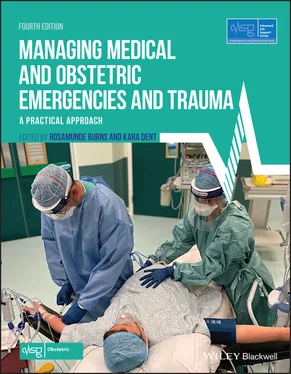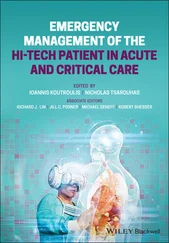Now the conversation goes:
Team leader (Liz):
‘Michael, can you please order four units of blood?’
Michael:
‘Okay, you’d like me to order four units of blood?’
Team leader:
‘Correct’
The loop is finally closed when Michael returns to the room and confirms that the specific allocated task has been done:
Michael:
‘Liz, the four units of blood are ordered and will be here in 5 minutes’
Team leader:
‘Noted Michael – thanks’
We now know that the message has been transmitted and received correctly. For this process to work both parties (the sender and receiver) need to understand and expect it – again demonstrating the need for us to practise and train together. The phrase ‘ Will someone … ’ is often used to avoid the embarrassment felt when you cannot remember someone’s name. In emergency situations this must be avoided – use alternative ways of attracting attention: you may need to point or wave at the team member! This is never easy, but is absolutely vital if tasks are to be allocated and completed effectively.
4.7 Team working, leadership and followership
At a basic level a team is a group of individuals with a common cause. Historically we have tended to train individually or in professional silos; the risk here is that we are making a ‘team of experts’ rather than an ‘expert team’. Often within healthcare our teams form at short notice and may arrive at different times. Much emphasis has previously been given to the role of the leader, but a leader cannot be a team on his or her own. Emphasis needs to be given to developing the other team members, the active followers. A good leader will be able to swap from the role of leader to follower as more senior staff arrive and agree to take over.
The leader’s role is multifaceted and includes directing the team; assigning tasks and assessing performance; motivating and encouraging the team to work together; and planning and organising. All leadership skills and behaviours need to be developed and practised. There are different leadership styles and the leader needs to choose an appropriate style for that situation. Effective communication is key and should be reviewed and reflected upon regularly. Constructive feedback can both be given and sought in order to facilitate continuously improving performance.
It is vitally important to have a clearly identified leader. There can be times when people come and go, or different specialties arrive, creating a situation where it may not be clear who the leader is. In some situations or institutions individuals will wear tabards or other forms of identification to mitigate against this uncertainty. If there is a scribe recording events they should record who is leading and any changes to the leader.
Physical position of the leader
As soon as the leader becomes hands on, and task focused, they are primarily concentrating on the task at hand. This becomes the focus of their thoughts and they lose situation (or situational) awareness (i.e. their objective overview of the situation – see Section 4.8). The term ‘situational leadership’ is used to describe the fact that leadership can change as an emergency develops. If the leader is required to undertake a specific technical task, he/she must hand over leadership at that point. An example would be a situation where the consultant has assumed situational leadership during a shoulder dystocia. The midwife is unable to rotate the shoulders internally and asks the consultant to take over. As the consultant moves in to examine with the aim of removing the posterior arm, he/she must delegate ‘situational leadership’ to someone else – this will often be the senior midwife in the room.
The leader should be standing in an optimal position where they can gather all the information and ideally view the patient, the team members and the monitoring and diagnostic equipment. This enables them to recognise when a member is struggling with a task or procedure and support them appropriately.
Ideally the team should meet before the event and have the opportunity to introduce each other, and clarify roles and actions in emergencies. Sometimes this can be facilitated at the beginning of a shift but at other times it is impossible to predict or arrange. It is important, therefore, that individuals identify themselves to the leader as they arrive and roles are agreed, allocated and understood. A lot of the time their role may be determined purely in relation to the specific bleep the individual carries, but it is important that team members are flexible, for example if three airway providers are first on the scene we would expect other tasks to also be undertaken.
The followers have roles that are as mission critical as the leader. Followers are expected to work within their scope of practice but also take the initiative. No one would expect to turn up at a ward emergency and have a neat row of staff against the wall waiting for instructions. It is important to think about the level of communication required between the leader and followers. If it is obvious we are doing a task, this does not need to be communicated. There is a risk that followers can overwhelm the leader with verbal communications where, in fact, the key is to communicate concerns or abnormal things. In the Formula One pit lane during a tyre change, the crew communicate (visually) as tasks are completed; they also signal if they have a problem, they do not communicate verbally at every expected step.
Within the team there needs to be a hierarchy. This is the ‘power gradient’; the leader is at the top of this as the person coordinating, directing and making the decisions. However, this should not be absolute. There is much discussion in the literature about the degree of the hierarchical gradient. If it is too steep the leader has a massive position of power, his or her decisions are unquestionable and the followers blindly follow the orders. This is not safe because leaders are humans too and also make errors – their team is their safety net.
Safe practice is achieved where the followers feel they can raise concerns or question instructions. This must always be understood by the leaders as much as by the followers. One way to reduce the hierarchy gradient is for the leader to invite the team’s thoughts and concerns, particularly around patient safety issues. It is also important for the follower to learn how to raise concerns appropriately. This is often referred to as ‘flattening the hierarchial pyramid’ – the leader is ‘nearer’ to his/her team, actively listening to concerns raised, whilst team members undertake allocated tasks effectively and feel empowered to ‘challenge’ or raise concerns.
One acronym that is sometimes used to raise concerns in a format which escalates appropriately is PACE ( probe, alert, challenge and finally declare an emergency). The probing question allows diplomacy and maintenance of the hierarchy whilst raising the relevant concern.
| Stage |
Level of concern |
| PProbe |
’Do you know that …’ |
| AAlert |
’I’m more concerned now …’ |
| CChallenge |
’Please stop what you’re doing and consider …’ |
| EEmergency |
’I need you to stop immediately because …’ |
These stages are described with examples below:
Читать дальше












